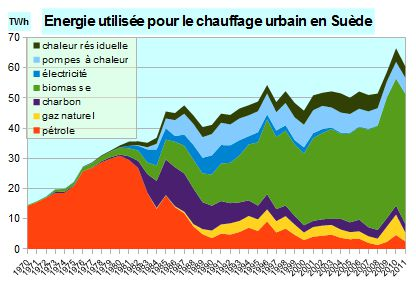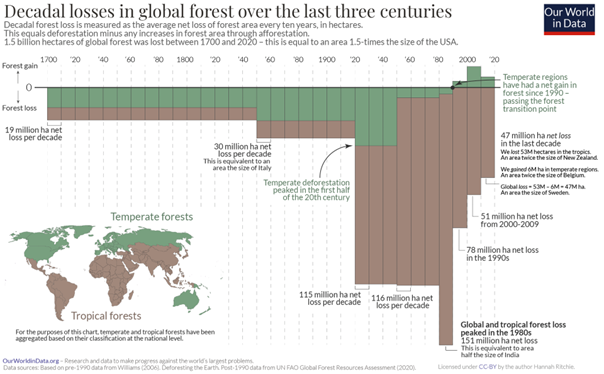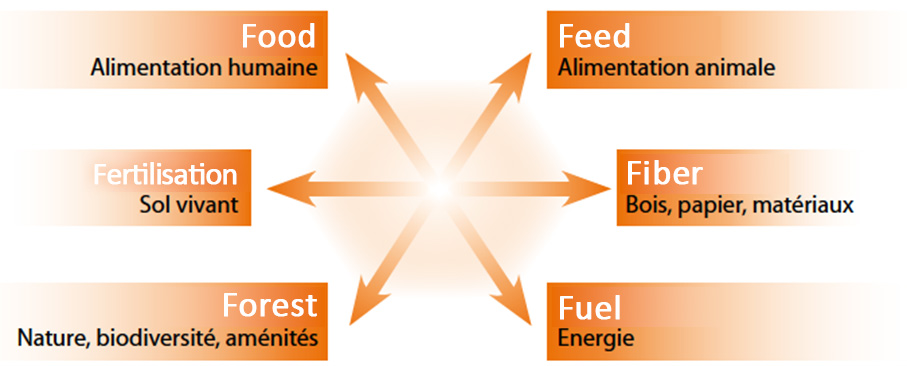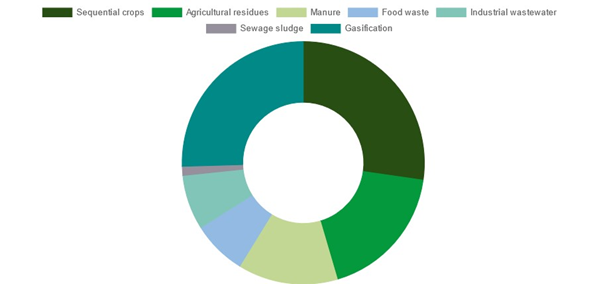Climate and energy
Claire Tutenuit
-

Available versions :
EN
Claire Tutenuit
General Delegate of the French association of Entreprises pour l’Environnement, member of the French Economic, Social and Environmental Committee
Biomass refers to all organic matter that can be used as a source of energy - in other words, just about everything. The term includes products from forests and agriculture, and even from the sea (algae). They can be used either directly (wood energy, waste incineration) or after methanisation of the organic matter (biogas) or further chemical transformation (biofuels). They can also be used for composting. Of course, most organic matter also has other uses, with energy use traditionally considered to be the lowest priority, as it draws the least benefit from the physical and chemical properties of organic matter. The hierarchy of uses for wood, for example, is as follows: the trunks are devoted to noble uses such as construction and furniture; the branches are used as industrial wood for plywood, packaging or paper and cardboard; what remains (the waste from felled trees) is allocated to energy purposes unless it is left in place to form forest soils. However, heating plants are now being supplied with industrial wood. The same applies to the hierarchy of uses for agricultural products: food or materials (fibres) are the priority uses and the best valued, followed by return to the soil (straw, green manure, manure, etc.) and finally methanisation or incineration, generally of waste alone. However, plants that used to be grown for food (maize or peas) are now beginning to be methanised.
The ecological transition is turning these hierarchies on their head, as several sectors dependent on large quantities of fossil fuels have no alternative or feed to use biomass to reduce their emissions. Biomass is therefore once again of interest to European countries, as illustrated by the case of district heating networks in Sweden.

Besides, biomass, whether forest or agricultural, provides other non-marketable but very useful services to mankind: it absorbs carbon dioxide, regulates surface or underground fresh water and supports biodiversity. Over-exploitation is one of the main pressures leading to biodiversity loss, which is as critical as global warming. It also leads to a reduction in the absorption of carbon dioxide, exacerbating the challenge of carbon neutrality.
Europe is not alone in its need for biomass, far from it, and it is trying to reduce the pressure it exerts on tropical resources, which are also overexploited, as shown in the diagram for forests below. This is leading it to turn first to its own resources, at the risk of overexploiting them: the graph below shows an initial reversal in the trend for the size of Europe's forests.

Carsten Spohr, CEO of Lufthansa, recently sounded the alarm regarding the disproportion between Europe's biomass requirements and the continent's available supplies, following the announcement of the new European standard for the incorporation of Sustainable Air Fuels (SAF) in aviation fuels: “From today's point of view, it won't even be possible to have the quantities required, not to mention the high costs that passengers will have to bear in the end.”
The new European standard sets the minimum level of SAF in aircraft fuel tanks at 2% from 2025, a threshold that will be gradually increased, reaching 70% in 2050. With this decision, Europe will be leading the way in decarbonising air transport. "This is the biggest SAF incorporation mandate in the world," says Matteo Mirolo, a specialist in sustainable aviation at Transport & Environment (T&E).
On a world scale, SAF’s only account for 0.1% of airline fuel, compared with 0.2% at Lufthansa. Can we multiply this by 10 in two or three years? It's an industrial challenge, of course, but also one in terms of resources: where are the raw materials for these SAF going to come from, and will other uses of biomass have to be reduced to meet the demand for air transport?
This is not the only issue: all sectors of the European economy are separately developing decarbonisation strategies based on replacing fossil fuels with renewable raw materials. Conflicts of use therefore seem likely, with undesirable economic effects such as impacts on food prices... and negative environmental impacts on Europe's ecological transition, linked to the overexploitation of soil and biomass.
Growth in European biomass use
A number of sectors, and electricity generation itself, cannot easily substitute the fossil fuels used with decarbonised electricity, and have therefore built decarbonisation roadmaps based on biomass, which is less costly than hydrogen from renewable sources or synthetic fuels:
- Solid biomass, whether wood or waste, and biogas remain essential for peak winter heating or for heating networks, as shown by the already significant volumes of pellets imported from Canada and the United States, with around five million tonnes imported into Europe in 2022 and 2023.
- It is difficult to substitute gas as a raw material in the manufacture of fertilisers, petrochemicals and plastics.
- Gas is still the planned alternative to fossil fuels for heavy transport, which is difficult to electrify: heavy trucks, ships, and so on.
- Air transport and agricultural machinery can only be decarbonised by 2050 using biofuels, again at least during the wait for synthetic fuels and, later, hydrogen.
- The manufacture of cement and steel increasingly uses solid recycled fuels or other renewable fuels.
The combined effect of the forecasts for consumption of biomass for these new uses could lead to a significant excess in demand for biomass compared with what is currently available and unused. However, what we mean by "unused" needs to be qualified: unused biomass returns to the soil, where it helps to maintain the content of organic matter in the soil and therefore soil fertility. A different use could lead to greater reliance on industrial inputs, with a corresponding increase in industrial and agricultural emissions.
The study TYFA (Ten years for agroecology) published in 2018, demonstrated this already, indicating that if an agroecological transition in Europe was possible, feeding the population without pesticides or chemical nitrogen fertilisers... there would then be very few resources left to satisfy energy requirements. These difficulties are now beginning to emerge.
First warnings about logging
The first conflicts regarding the use of forests have arisen in recent years: forest biomass (wood and waste) accounts for around 60% of the renewable energy used in Europe, and requirements for the use of this for industrial and energy purposes are growing. As a result, there have been a number of warnings on the subject, particularly by the PFPI, which published a report at the end of 2022 on the gathering pace of forest extraction in Europe, warning of the increase in harvesting and its consequences: European directives encouraging the use of biomass as a renewable energy source have led to a two-fold increase in this since the 1990s.
The consequence of this trend has been a sharp reduction in Europe's carbon sink, observed in most forested countries since the early 2000s, and this has been attributed to two causes: the intensification of the use of wood for energy purposes, and dieback caused by drought, fire and pests, which has been greatly accelerated by climate change. How can we reconcile the conflict between carbon dioxide absorption and forest production? If absorption decreases, the emission reductions required to achieve carbon neutrality will be even more demanding.
At the end of 2022 the European Parliament took first steps to reverse the trend, in particular by providing for a gradual reduction in the amount of wood allocated directly to energy uses and a reduction in incentives for the development of wood-based energy. The debate remains open as to how to achieve this reversal so as to safeguard carbon dioxide absorption and air quality, both of which are degraded by wood combustion.
However, biomass resources from forests are not the only ones to be used for the ecological transition: agriculture will be just as much in demand as forests to achieve the ecological transition laid out in the Green Deal, in addition to the many current uses of biomass, as shown in the diagram below.

An examination of the roadmaps of various sectors for their ecological transition reveals sharp increases in demand, the satisfaction of which will depend on the resources that can be devoted to each of these sectors. Three examples illustrate this: agrofuels, sustainable aviation fuels and biogas.
Agrofuels, a controversial solution
Agrofuels from crops (rapeseed, sunflower, soya), known as "first generation" and consumed in Europe, require almost 10 million hectares. However, according to some calculations, if this area were left to nature, it would absorb around 65 million tonnes of CO2, more than double the amount that current European production saves by substituting fossil fuels. At the same time, if a portion of these 10 million hectares were covered with photovoltaic panels, it could produce far more energy to power electric vehicles than can be provided by liquid fuels: to produce the same amount of energy, we would only need to devote 2.5% of Europe's surface area to solar energy, with the rest left in its natural state to absorb CO2, or dedicated to other crops. According to this logic, it would therefore be better to reserve agrofuels for purposes that cannot be replaced by electric motors, such as heavy transport or sea and air transport, rather than incorporating them across the board.
The development of these sectors is therefore the focus of difficult debates in the European Parliament, particularly with regard to the aid granted to these crops. Initial measures have been taken, such as the exclusion, by 2023, of palm and soya oil from the composition of biodiesels used in Europe - both have already been excluded in France since 2020, as well as in Denmark and the Netherlands, and palm oil is banned from engines in Germany and Italy.
The use of imported fuels or resources to fuel European production raises the same question as wood imports: even if the Directive on Deforestation-free supply chains reduces significantly the direct impact, what would the indirect impact be? What share in the world's agricultural production does Europe want, and will it be able to generate enough for its own needs without contributing to the pressure on all the world's ecosystems?
Aviation: ReFuel EU aviation
The aviation sector is also one of those whose decarbonisation roadmaps will make the greatest use of biomass: the transition to hydrogen-powered aircraft will not be technically possible on a massive scale before 2050, and the incorporation of Sustainable Air Fuels, agrofuels or synthetic fuels, is the only transition solution available in the meantime. The ReFuelEU Aviation regulation stipulates that the share of sustainable fuels in air transport should rise from less than 1% in 2022 to 2% in 2025, 6% in 2030, 34% in 2040 and 70% in 2050.
This justifies the questions asked by the CEO of Lufthansa about the biomass resources that will be allocated to this use, and the costs of its integration. In principle, this question will be resolved in a few years' time by the use of synthetic fuels, which could reuse CO2 from different sources. However, it is not certain that they can be produced without biomass, or that their cost will be competitive with that of biofuels.
A European partnership for biomethane
In 2021, European biogas and biomethane production represented around 3 billion m3 of biogas, or 196 TWh, equivalent to Belgium's gas consumption, or 4.5% of European gas consumption. It is forecast to grow considerably, both for the ecological transition and for strategic reasons.
In March 2022, the European Commission announced a biomethane production target of 35 billion m3 as part of its REPowerEU by 2030, designed to reduce the European Union's dependence on fossil fuels - Russian gas in particular - reduce energy consumption and diversify supplies. Europe consumes 400 billion m3 of gas. The priority is therefore to replace gas with electricity as soon as possible. Even so, this means a tenfold increase in biogas and biomethane production.
On 28 September 2023 the Biomethane Industrial Partnership (BIP) was launched across Europe. Its aim is to encourage all interested parties to work together to achieve the EU's biomethane objectives. This applies not only to the Member States, but also to businesses, academic institutions and civil society. The question arises, however, as to the resources that can be used for this tenfold increase in methanisation: intermediate crops are to account for a quarter, gasification (of forestry resources) for another quarter, and the remainder is due to come from straw and other agricultural residues, food waste, sludge from wastewater treatment plants, livestock manure and other waste from the agri-food industries, etc.

As farmers say, an anaerobic digestion plant is "an artificial rumen": methanisation is replacing livestock farming in areas that have gone from mixed crop-livestock systems (allowing fertilisation by meadow animals) to arable-only systems, with digestate replacing some of the nitrogen fertiliser. The question arises, however, of the carbon depletion of the land where this methanisation is practised, since a significant proportion of the carbon is removed to pass into the biomethane. How quickly and in what proportions? The German example, which has the longest track record since development began in the 2000s, has revealed a significant impact on farming systems, with a 4.5-fold increase in the area devoted to maize between 2007 and 2018, with a strong question mark hanging over the sustainable nature of these crops. Europe still lacks experience in terms of the impact of anaerobic digestion on soil fertility, cropping systems and agricultural and food production, but the areas concerned will be extended before all these questions can be answered.
Finally, the development of methanisation has so far been stimulated and organised by national policies. Germany, for example, has rapidly developed methanisation as a means of greening electricity production in power stations using this biogas. Most intermediate crops have been used for methanisation. France, on the contrary, has used biogas in the network and developed intermediate crops as "nitrate traps" rather than for energy recovery, to replace synthetic fertilisers. Can the European industrial partnership function without bringing these energy, industrial and agricultural policies closer together?
A cross-disciplinary approach
These three examples of biogas, agrofuels and aviation fuels show that, at European level, most of the thinking is being done on a sector-by-sector basis. Each industry expects its requirements and production to multiply significantly over the next few years. How will trade-offs be made if the demands are for the same resources?
Without public policy, the trade-off will be price, but with possible negative effects, as we have seen in the past with the American policies of incorporating agrofuels, which have caused pressure on the price of maize, a staple food in Mexico. European consumers cannot be left vulnerable to such crises, especially since they can be anticipated. If they have not yet occurred, it is precisely because decarbonisation has so far been abandoned (for example, by reducing the rate of incorporation of biofuels) when there a conflict of use has arisen. But decarbonisation is now a matter of urgency.
We therefore need to analyse and reflect on these issues across the board. Can intensification of land use be a solution and, if so, can it be achieved without compromising the restoration of biodiversity and the protection of natural areas, which are also the subject of ambitious commitments on the part of Europe? Which uses should be favoured, if a choice has to be made? What room for manoeuvre is there to increase the availability of biomass for these new uses? If these resources are imported, what will the direct or indirect effect be on global deforestation and therefore on the decarbonisation process?
Agricultural and forestry policies, energy and industrial policies, environmental policies and foreign trade - all of which are often decided at different levels of governance in the way Europe currently operates - will need to be brought closer together and harmonised. This is the only way to ensure that the ecological transition respects other major social interests and that these remain compatible with the ecological transition.
In any case, the issue of biomass governance requirements was the focus of an opinion of the French Economic Social and Environmental Committee in May 2023.
The opinion sets out four types of recommendation:
- Long-term sobriety: more than ever, the reduction in demand for energy and materials and the use of the circular economy must be encouraged, both in industry and among consumers, including a significant reduction in the proportion of animal proteins in people's diets.
- Developing knowledge: data exist on biomass flows, but in units that are difficult to reconcile: who knows how to transform tonnes of dry matter into tonnes of oil equivalent, cubic metres of gas or MWh? Who can compare tonnes of digestate from anaerobic digestion to tonnes of nitrogen fertiliser, in terms of emissions or impact on biodiversity? Who knows the total carbon footprint of a cow grazing a hectare of grassland and its effect on biodiversity? Knowledge of local flows is also essential, as biomass is difficult to transport and balances between supply and demand need to be established locally.
- Mechanisms to project flows and arbitrate between food and agricultural uses and the various industrial and energy uses. Should this be done by the farming community alone? Should the economic conditions for production be changed, and to what extent, at the risk of unbalancing certain markets? Should this be done by the industrial and energy authorities? Is there any way of limiting the number of factory-farmed animals consumed, whether they are imported or not? Can a limit be placed on the amount of wood or plant-based raw materials consumed, whether manufactured locally or imported?
- Financial incentives to preserve biodiversity: permanent grasslands and hedgerows can only survive if it is profitable to conserve them ; planted hardwood forests yield less and less quickly than coniferous monoculture plantations; on the other hand, they provide many more ecosystem services.
Moving over to the regulation of the volumes of biomass consumed, as is now the case in terms of greenhouse gas emissions, and as the European Union is beginning to consider for wood-energy, would require fairly radical changes to the rules of free trade practised by the European Union. Preserving a habitable planet might well come at this price.
How to move forward?
The current working methods consist, for each sector, of drawing up a decarbonisation roadmap at European level, mobilising significant quantities of biomass without giving ourselves the means to resolve the question of likely conflicts of use.
The method of starting with the available resource and looking at the most significant room for manoeuvre could undoubtedly be usefully implemented in Europe, if knowledge of the flows, their interrelationships (many productions serve several uses) and their prospects were brought together for the benefit of cross-cutting decisions.
The European Union has the authority and expertise to move forward with the design of a framework for arbitration and compromise to support the ecological transition:
- External trade rules are one of the essential keys: applying the same environmental rules to imports as to European producers would speed up the ecological transformation of European agriculture and industry. The Carbon Border Adjustment Mechanism is a start; clauses to this effect in free trade agreements should be considered essential, which they are not at present.
- The Common Agricultural Policy could be reviewed to promote the transition to a European food system in line with WHO recommendations, in terms of quality (reduction of chemical inputs, grass-fed or labelled livestock farming) and quantity, and the ecological transition.
- A cap on the quantities of biomass that can be used in Europe would allow external trade and free trade within borders to flourish; it would ensure that Europe does not contribute to deforestation in the rest of the world and would guarantee fairness with other countries that will need their biomass. The European Union has already taken these steps in terms of greenhouse gas emissions.
A certain amount of time will be required to define and then decide these changes in biomass governance. The first step would of course be for Europe to rapidly set up a biomass observatory, which would gather data from both the agricultural and the energy and industrial worlds, and to encourage the Member States to do likewise. This observatory would be in a position to inform political decision-makers in defining the policies that will allow Europe to succeed in its ecological transformation and meet its essential needs with a limited quantity of biomass.
This is one of the most sensitive areas of ecological transformation, since it is the one where the climate and biodiversity issues are most at odds with each other... the solution undoubtedly lies in Europeans' sobriety being explained and accepted in the long term, backed by new governance mechanisms that have yet to be invented.
Publishing Director : Pascale Joannin
To go further
Gender equality
Fondation Robert Schuman
—
23 December 2025
Businesses in Europe
Olivier Perquel
—
16 December 2025
Digital and technologies
Josef Aschbacher
—
9 December 2025
Democracy and citizenship
Florent Menegaux
—
2 December 2025

The Letter
Schuman
European news of the week
Unique in its genre, with its 200,000 subscribers and its editions in 6 languages (French, English, German, Spanish, Polish and Ukrainian), it has brought to you, for 15 years, a summary of European news, more needed now than ever
Versions :




